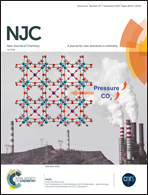High thermal stability of the Ru–ON (MS1) linkage isomer of the ruthenium nitrosyl complex [RuNO(Py)4F](ClO4)2 with the trans NO–Ru–F coordinate†
Abstract
The reaction of [RuNO(Py)4OH](PF6)2 with hydrofluoric acid results in the formation of the [RuNO(Py)4F]2+ cation with good yield. The perchlorate salt [RuNO(Py)4F](ClO4)2 was separated and characterized by elemental analysis, IR spectroscopy, and single crystal and powder X-ray diffraction. Though the crystal structure of the salt contained two crystallographically independent [RuNO(Py)4F]2+ cations, the bond distances differed by no more than 0.005 Å, and only one ν(NO) vibration band (1907 cm−1 at room temperature) was observed in the IR spectra of the salt. Blue light irradiation (445 nm) at 80 K resulted in the formation of the MS1 linkage isomer with Ru–ON coordination which could be converted to the MS2 linkage isomer (Ru–η2NO coordination) upon IR (980 nm) irradiation. The achieved conversion is equal to 20–23% for the MS1 isomer and 17% for the MS2 isomer. The thermal decay of both metastable isomers was investigated by IR spectroscopy and DSC. The decay temperature for the MS2 isomer was 185 K. For the MS1 isomer, the decay temperature of [RuNO(Py)4F](ClO4)2 (289–291 K) was the highest of all known ruthenium nitrosyl complexes.
2 with the trans NO–Ru–F coordinate](/en/Image/Get?imageInfo.ImageType=GA&imageInfo.ImageIdentifier.ManuscriptID=C8NJ04620D&imageInfo.ImageIdentifier.Year=2018)


 Please wait while we load your content...
Please wait while we load your content...